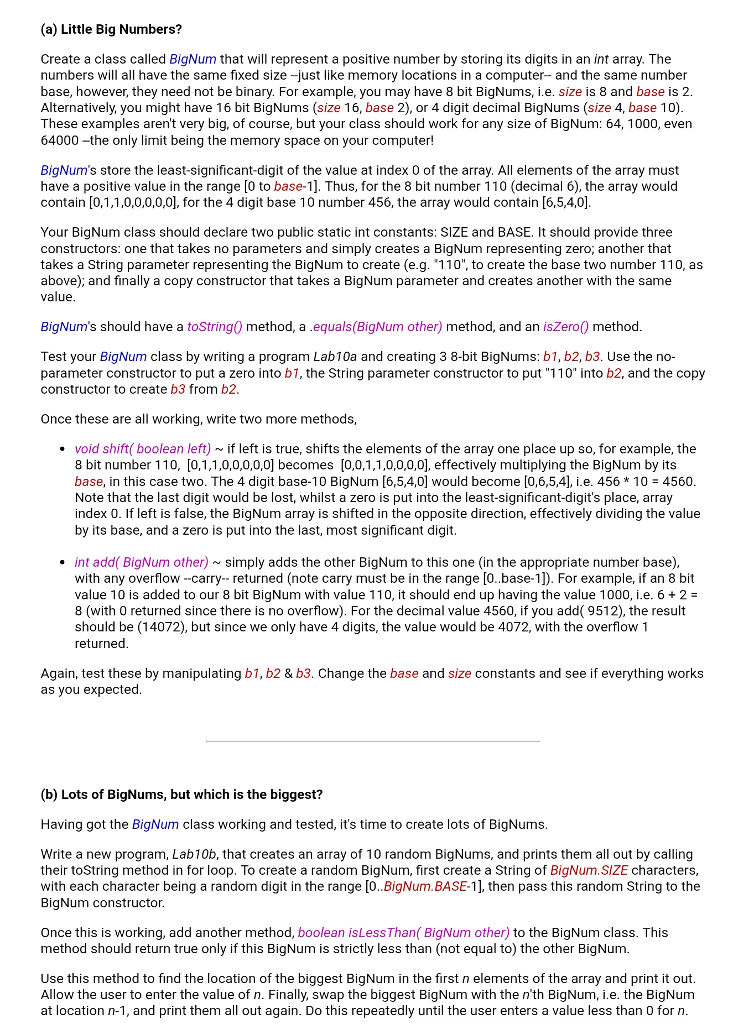I need java code

(a) Little Big Numbers? Create a class called BigNum that will represent a positive number by storing its digits in an int array. The numbers will all have the same fixed size -just like memory locations in a computer- and the same number base, however, they need not be binary. For example, you may have 8 bit BigNums, i.e. size is 8 and base is 2. Alternatively, you might have 16 bit BigNums (size 16, base 2), or 4 digit decimal BigNums (size 4, base 10) These examples aren't very big, of course, but your class should work for any size of BigNum: 64, 1000, evern 64000 -the only limit being the memory space on your computer! BigNum's store the least-significant-digit of the value at index 0 of the array. All elements of the array must have a positive value in the range [0 to base-1]. Thus, for the 8 bit number 110 (decimal 6), the array would contain [0,1,1,0,0,0,0,0], for the 4 digit base 10 number 456, the array would contain [6,5,4,0] Your BigNum class should declare two public static int constants: SIZE and BASE. It should provide three constructors: one that takes no parameters and simply creates a BigNum representing zero; another that takes a String parameter representing the BigNum to create (e.g. 110", to create the base two number 110, as above); and finally a copy constructor that takes a BigNum parameter and creates another with the same value BigNum's should have a toStringO method, a equals(BigNum other) method, and an isZero) method Test your BigNum class by writing a program Lab10a and creating 3 8-bit BigNums: b1, b2, b3. Use the no- parameter constructor to put a zero into b1, the String parameter constructor to put "110" into b2, and the copy constructor to create b3 from b2 Once these are all working, write two more methods, void shift(boolean left) if left is true, shifts the elements of the array one place up so, for example, the 8 bit number 110, [0,1,1,0,0,0,0,0] becomes [0,0,1,1,0,0,0,0], effectively multiplying the BigNum by its base, in this case two. The 4 digit base-10 BigNum [6,5,4,0] would become [0,6,5,4], i.e. 456 10 4560 Note that the last digit would be lost, whilst a zero is put into the least-significant-digit's place, array index 0. If left is false, the BigNum array is shifted in the opposite direction, effectively dividing the value by its base, and a zero is put into the last, most significant digit . int add( BigNum other) ~simply adds the other BigNum to this one (in the appropriate number base) with any overflow -carry returned (note carry must be in the range [0..base-1]). For example, if an 8 bit value 10 is added to our 8 bit BigNum with value 110, it should end up having the value 1000, i.e. 6 2- 8 (with 0 returned since there is no overflow). For the decimal value 4560, if you add( 9512), the result should be (14072), but since we only have 4 digits, the value would be 4072, with the overflow 1 returned Again, test these by manipulating b1, b2 & b3. Change the base and size constants and see if everything works as you expected (b) Lots of BigNums, but which is the biggest? Having got the BigNum class working and tested, it's time to create lots of BigNums Write a new program, Lab10b, that creates an array of 10 random BigNums, and prints them all out by calling their toString method in for loop. To create a random BigNum, first create a String of BigNum. SIZE characters, with each character being a random digit in the range [0.BigNum.BASE-1], then pass this random String to the BigNum constructor Once this is working, add another method, boolean isLessThan( BigNum other) to the BigNum class. This method should return true only if this BigNum is strictly less than (not equal to) the other BigNum. Use this method to find the location of the biggest BigNum in the first n elements of the array and print it out. Allow the user to enter the value of n. Finally, swap the biggest BigNum with the n'th BigNum, i.e. the BigNum at location n-1, and print them all out again. Do this repeatedly until the user enters a value less than 0 for n







